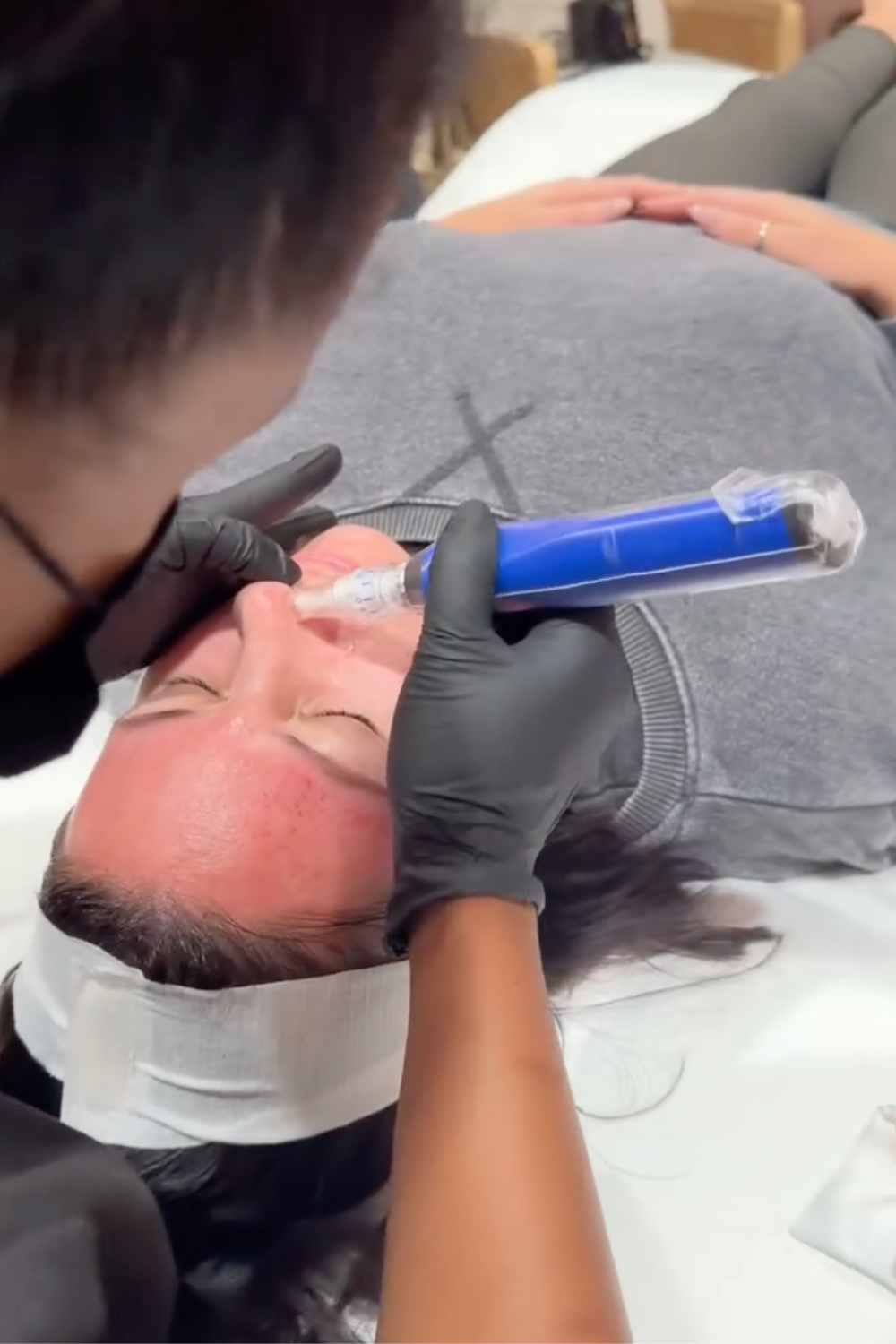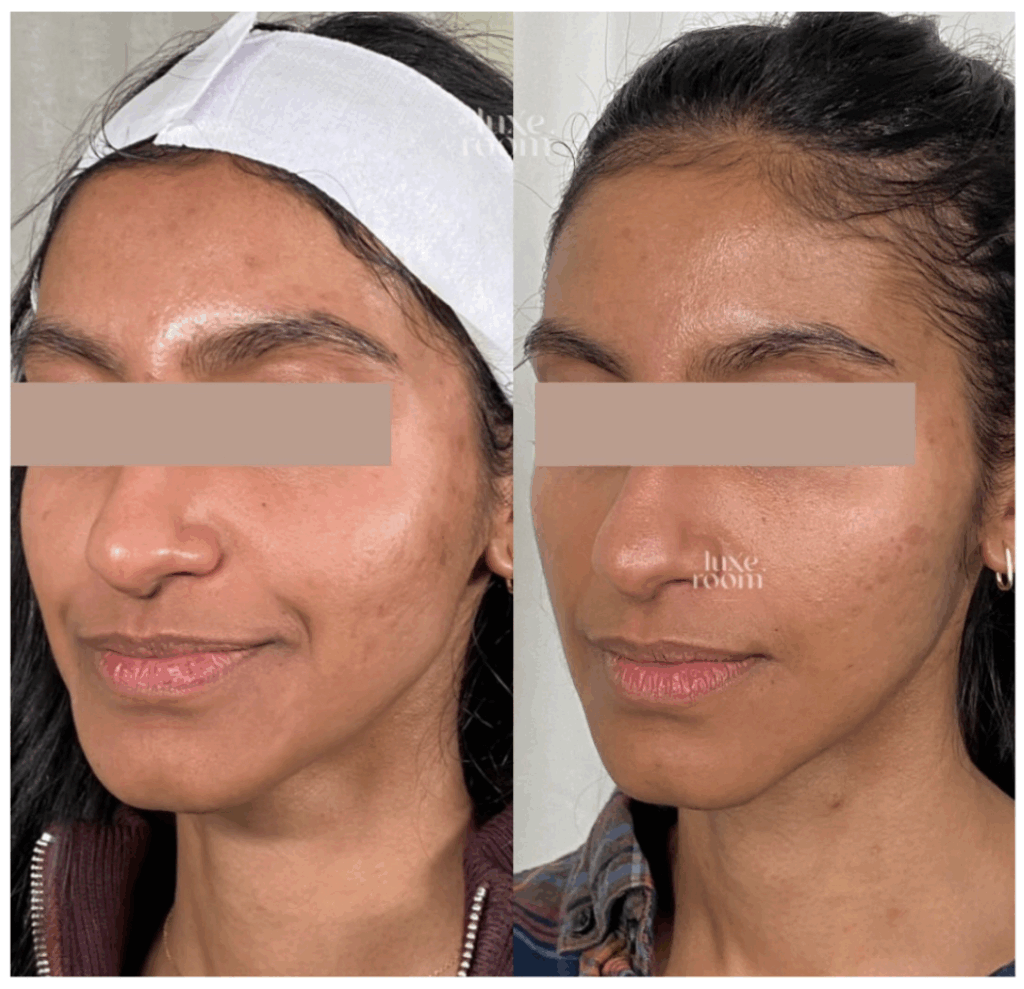Is SkinPen Microneedling Worth It? Here’s the Full Breakdown
You’ve probably seen it on IG—someone looking a little lobster-y after a treatment, then glowing with glass skin a few days later. That’s the beginning of a microneedling glow-up, and yes, we’ve documented more than a few of those journeys ourselves.
SkinPen is our microneedling device of choice at The Luxe Room. It’s the first FDA-cleared microneedling tool on the market, and it delivers smoother texture, softer lines, and brighter, more even-toned skin—all by tapping into your skin’s natural ability to heal and regenerate.
Now, we get it. The idea of poking tiny holes in your face might not sound appealing at first. But the things we do for beauty, right? The good news is it’s not just trendy—there’s real science behind the glow, and it works.
In this guide, we’re breaking down everything you need to know about SkinPen: how it works, what it treats, what it feels like, and why so many of our clients swear by it.

How SkinPen Works (and Why It’s So Effective)
At its core, SkinPen microneedling is a controlled way of tricking your skin into doing what it already knows how to do—heal and regenerate. The device uses 14 ultra-fine needles in a sterile, single-use cartridge to create thousands of teeny-tiny microchannels across the skin.
These are precise punctures, not scratches, and they can be adjusted anywhere from 0.25 mm to 2.5 mm deep, depending on the area we’re treating and what we’re working on (think: texture, scars, fine lines).
Here’s a little skin anatomy to explain why that depth matters. The outermost layer of your skin is the epidermis. Below that is the dermis—that’s where your collagen and elastin live, and that’s the zone we’re aiming for. If you see a little pinpoint bleeding during your treatment, don’t panic—it’s actually a sign we’ve reached the dermis and its web of blood vessels.
Once those micro-injuries are made, your body jumps into repair mode. First, there’s a quick cleanup phase (inflammation), followed by a boost in new skin cell production (proliferation), and then the grand finale: remodeling. That’s when collagen and elastin get rebuilt and reorganized, giving your skin a firmer, smoother, more even appearance.
Microneedling is also considered a resurfacing treatment—which basically means we’re encouraging that fresh, baby-soft skin to rise to the surface. And your mission, post-treatment, is to protect this brand new glowy skin and treat it with extra care.
Why Get the SkinPen Treatment (vs. At-Home Devices and Other Microneedling Tools)
Let’s clear something up: not all microneedling methods are created equal. You’ve got at-home rollers, automated pens, and then there’s RF Microneedling and SkinPen—both tools we use here at The Luxe Room. So why do we keep going back to SkinPen? Simple: safety, precision, and results.
First up—at-home rollers. These are the little handheld tools with fixed needles that you roll over your skin. The rolling motion can actually drag across the surface, creating uneven micro-tears instead of clean punctures. That can lead to inflammation, irritation, and in some cases, even pigmentation issues. Add in the fact that most people don’t sterilize them properly or replace them as often as they should, and… you get the idea.
Then there are other in-office microneedling pens. A few brands are out there (Dermapen, Rejuvapen, and others), and while they’re also motorized and designed to stamp the skin vertically, SkinPen still comes out ahead. Why? It was the first FDA-cleared device on the market, which means it’s been rigorously tested for safety and effectiveness.
Its cartridge is completely sealed (so no risk of backflow or contamination), and we can adjust the depth of the needles mid-treatment to customize it for different areas of your face. More fragile zones like under the eyes need a different approach than, say, the cheeks or jawline—and SkinPen gives us that kind of control.
And RF microneedling? Also in our toolkit. It’s best for deeper concerns like skin laxity, deeper wrinkles and more stubborn acne scars. While SkinPen focuses on surface texture and collagen renewal, RF adds heat to tighten and firm from deeper within.

What Does SkinPen Treat?
Microneedling with SkinPen is incredibly versatile. It’s popular for acne scars, but not limited to it, in fact it’s fantastic for fine lines and wrinkles. We use it to address:
- Acne scars (including deep boxcar and icepick scars)
- Stretch marks
- Fine lines and crepey texture
- Enlarged pores
- Mild to moderate hyperpigmentation or melasma
- Early skin laxity (especially in the lower face, neck, and chest)
It can even be used on delicate areas like under the eyes, around the mouth, and on the hands—where skin is thinner and more reactive.
Microneedling Add-Ons That Amplify Results
One of the coolest things about microneedling? It opens a temporary window where your skin is extra absorbent. Right after treatment, those tiny microchannels give us a chance to deliver high-performance serums deeper into the skin, where they can actually do something.
Here are a few of our favorite upgrades we pair with SkinPen at The Luxe Room, depending on what your skin’s craving:
Sculptra (poly-L-lactic acid): This one’s a collagen stimulator, not a filler. We apply it topically after microneedling to support long-term skin density and firmness. It’s especially great if your goal is thicker, more resilient skin over time—think subtle structure, not puff.
PDGF (platelet-derived growth factor): This growth factor is a go-to when your skin’s in recovery mode. It helps accelerate the healing process, encourages tissue regeneration, and is especially helpful for under-eye rejuvenation, after acne, inflammation, or if we’re working on compromised areas.
Salmon Sperm DNA: Sounds a little wild, but trust—it’s packed with antioxidants and nucleotides that promote cell renewal and elasticity. We love this one for dull, tired, or aging skin that could use a reboot.
The Luxe Room Microneedling Experience: What the Appointment Is Like
We always start with a consultation to make sure your skin is ready and that the treatment is aligned with your goals. After cleansing your skin, we apply a prescription-grade numbing cream and let it sit for 20 to 30 minutes. This helps minimize discomfort—most people describe the sensation as a buzz or mild scratchiness, with a bit more sensitivity around areas like the forehead and upper lip.
The treatment itself usually takes about 30 to 45 minutes, depending on the size of the area. You might notice some pinpoint bleeding or a bit of swelling, both of which are totally normal. Immediately afterward, your skin will look red—like a moderate sunburn—and feel warm or tight.
Aftercare: What Not to Do After Microneedling
Your skin’s healing, your collagen’s kicking into gear—now’s the time to protect all that progress. Here’s what to avoid in the first few days post-treatment (trust us, it’s worth it):
No sweaty workouts. Yep, even your favorite hot yoga class needs to wait. Sweat can irritate freshly microneedled skin and introduce bacteria into those microchannels.
Skip the sauna and steam room. Excess heat can prolong redness and swelling. Give your skin a few days before diving back into anything that makes you sweat.
No hot showers or baths. Keep the water lukewarm when you cleanse. Super hot water can sting and strip your skin’s barrier while it’s in recovery mode.
Hold the actives. That means no retinoids, AHAs, BHAs, vitamin C serums, or exfoliants until we say so. They’re powerful—but too much, too soon, can cause irritation.
No makeup for at least 24 hours. Give your skin time to settle before applying anything occlusive or pigment-based.
Avoid touching your face. It’s tempting—but those freshly opened microchannels are vulnerable to bacteria. Hands off, and absolutely no scratching.
No direct sun exposure. This one’s huge. Your skin is more sensitive to UV damage post-treatment, so SPF isn’t optional—it’s your ride-or-die.
Downtime: What the Week After Microneedling Looks Like
Microneedling recovery isn’t dramatic, but it’s not a lunchtime facial situation either. Your skin just got (gently) injured on purpose, and now it needs a bit of TLC. Here’s what most of our clients experience after a SkinPen treatment, day by day:
Day 1: Expect redness—somewhere between light flush and tomato, depending on how deep we went. Your skin might feel warm and tight, like a mild sunburn. Keep things simple. No touching, no makeup, no fancy serums. Just keep it clean and hydrated.
Day 2: Redness usually starts to settle, though a bit of puffiness can linger (especially around areas like the jawline or under the eyes). Still no workouts or hot showers. Think: rest day, but for your face.
Days 3–4: You might notice a little flaking, especially around the nose and mouth. Totally normal. That’s just your old skin making way for the new. Don’t exfoliate. Don’t pick. Moisturizer is your best friend.
Days 5–6: Texture starts to smooth out. Your skin may still feel a bit tight or dry, but that post-treatment glow is slowly creeping in. Most people feel confident enough to go makeup-free around now (if they weren’t already).
Day 7: Your skin’s hitting its stride. It looks clearer, brighter, and just… better.

When You’ll See Results—and How Many SkinPen Sessions to Plan For
Some people notice that soft glow within a few days—especially if we paired your treatment with a collagen-boosting add-on like growth factors or Sculptra. But if we’re talking about real texture changes, like smoothing scars or firming crepey skin, those shifts happen more gradually.
The sweet spot tends to hit between four and twelve weeks post-treatment, when your collagen is in full-on rebuild mode.
Most clients start with a series of three treatments, spaced about four to six weeks apart. If we’re working on deeper acne scarring or stretch marks, you might need closer to five or six treatments to get the best outcome. Once your initial series is done, one or two maintenance sessions a year is usually all it takes to keep your results on track.
Is SkinPen Microneedling Safe?
Yes—when done with the right device and by the right hands, SkinPen microneedling is considered one of the safest resurfacing treatments available.
SkinPen was the first FDA-cleared microneedling device, and it’s designed with precision and safety in mind. The needles are sterile, single-use, and medical-grade. The depth is adjustable and consistent, so we can tailor your treatment to your skin type and concerns without going too far.
That said, like any treatment, safety also depends on the provider. Microneedling can cause problems when:
- The device isn’t sterile or medical-grade
- The technique is too aggressive
- The skin is already compromised (like with active acne or a rash)
- Incompatible products are applied post-treatment
At the Luxe Room, we’re especially careful with what goes on your skin after the treatment. SkinPen creates thousands of microchannels, which temporarily increase absorption. That’s amazing for targeted serums and growth factors—but risky if the wrong product gets in. In rare cases, people have experienced allergic reactions or granulomas from topicals that weren’t meant to go that deep.
Who Shouldn’t Get SkinPen Microneedling?
There are a few conditions that would make us hold off or modify the treatment. These include:
- Active skin infections or open wounds in the treatment area (including active acne breakouts, herpes, etc.).
- Active inflammatory skin conditions like eczema or psoriasis flares in the treatment area.
- History of keloid scarring.
- Pregnancy.
- Recent use of isotretinoin (Accutane) (requires a waiting period).
- Uncontrolled diabetes or bleeding disorders (due to compromised healing or increased risk of bleeding).
We’ll always assess your skin and medical history during your consult to ensure microneedling is appropriate and safe.
So, Is SkinPen Microneedling Worth It?
We think so—because we’ve seen the results. SkinPen microneedling offers a balance we love: it’s clinically grounded, minimally invasive, and capable of delivering real results. Whether you’re looking to refresh your glow, target old scars, or simply future-proof your face, it’s one of the most versatile tools in our skincare toolkit.
Book a consult with us, and we’ll walk you through it step-by-step. Because great skin is personal—and so is our approach.



